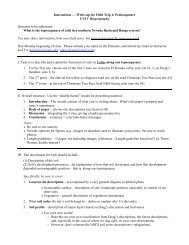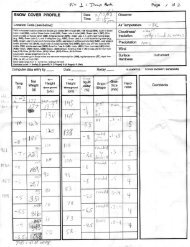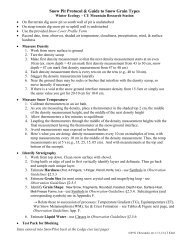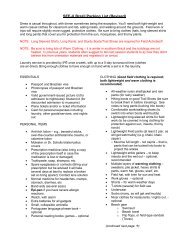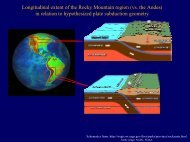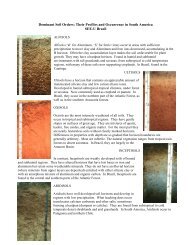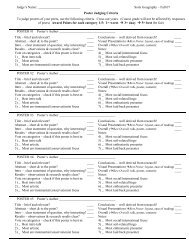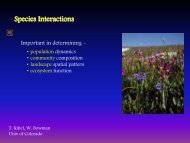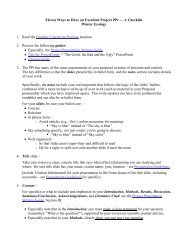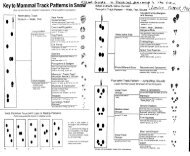Dominant Soil Orders1
Dominant Soil Orders1
Dominant Soil Orders1
You also want an ePaper? Increase the reach of your titles
YUMPU automatically turns print PDFs into web optimized ePapers that Google loves.
MOLLISOLS <br />
Mollisols have a dark-colored, organic-rich surface horizon (A horizon) and are found<br />
largely in grasslands. They occur from tropical to cold temperate, and from subhumid<br />
to semiarid environments.<br />
SPODOSOLS<br />
Spodosols have moderately acidic sandy profiles with an ashywhite<br />
upper horizon. In these soils, amorphous mixtures of<br />
organic matter and aluminum, with or without iron, have<br />
accumulated. They are typical of sandy soils under cool, wet<br />
conditions under conifer and hardwood forests such as in the<br />
boreal/cold temperate forests of Canada.<br />
GELISOLS <br />
Gelisols are soils that have permafrost within 100 cm of the soil<br />
surface and/or have gelic materials within 100 cm of the soil<br />
surface and have permafrost within 200 cm. Gelic materials are<br />
mineral or organic soil materials that have evidence of<br />
cryoturbation (frost churning) and/or ice segeration in the active<br />
layer (seasonal thaw layer) and/or the upper part of the permafrost.<br />
Occur in arctic and subarctic regions. Permafrost influences<br />
pedogenesis through its effect on the downward movement of the<br />
soil solution and on the soil forming processes.<br />
HISTOSOLS<br />
Histosols are dominantly organic. They are mostly soils that are<br />
commonly called bogs, moors, or peats and mucks. A soil is<br />
classified as Histosols if it does not have permafrost and is<br />
dominated by organic soil materials.<br />
ENTISOLS <br />
Entisols are recent soils with little or no profile development. At<br />
the most, have a weak organic matter surface layer (O horizon).<br />
Include deep, uniform sandy aeolian deposits (pictured here) to<br />
complex fluvial deposits. Some Entisols have steep, actively<br />
eroding slopes, and others are on flood plains or glacial outwash<br />
plains that frequently receive new deposits of alluvium.<br />
VERTISOLS<br />
Vertisols have a high content of expending clay and that have at<br />
some time of the year deep wide cracks. They shrink when drying<br />
and swell when they become wetter.<br />
______________<br />
1 Descriptions and images from–<br />
- NRCS http://soils.usda.gov/technical/classification/orders/ (Accessed 6/13/04)<br />
- Brady NC. RR Weil. 2008. The Nature and Properties of <strong>Soil</strong>s. Prentice-Hall. Ch 3.<br />
- Donahue, RL, R Miller, J Shickluna. 1983. <strong>Soil</strong>s: An Introduction to <strong>Soil</strong>s and Plant<br />
Growth. 5th Ed. Prentice-Hall.<br />
Other resources –<br />
http://soils.cals.uidaho.edu/soilorders/orders.htm<br />
http://soils.ifas.ufl.edu/faculty/grunwald/teaching/e<strong>Soil</strong>Science/soil_orders.shtml<br />
T.Kittel 604, 211



